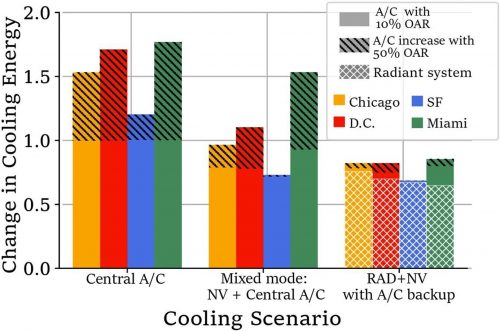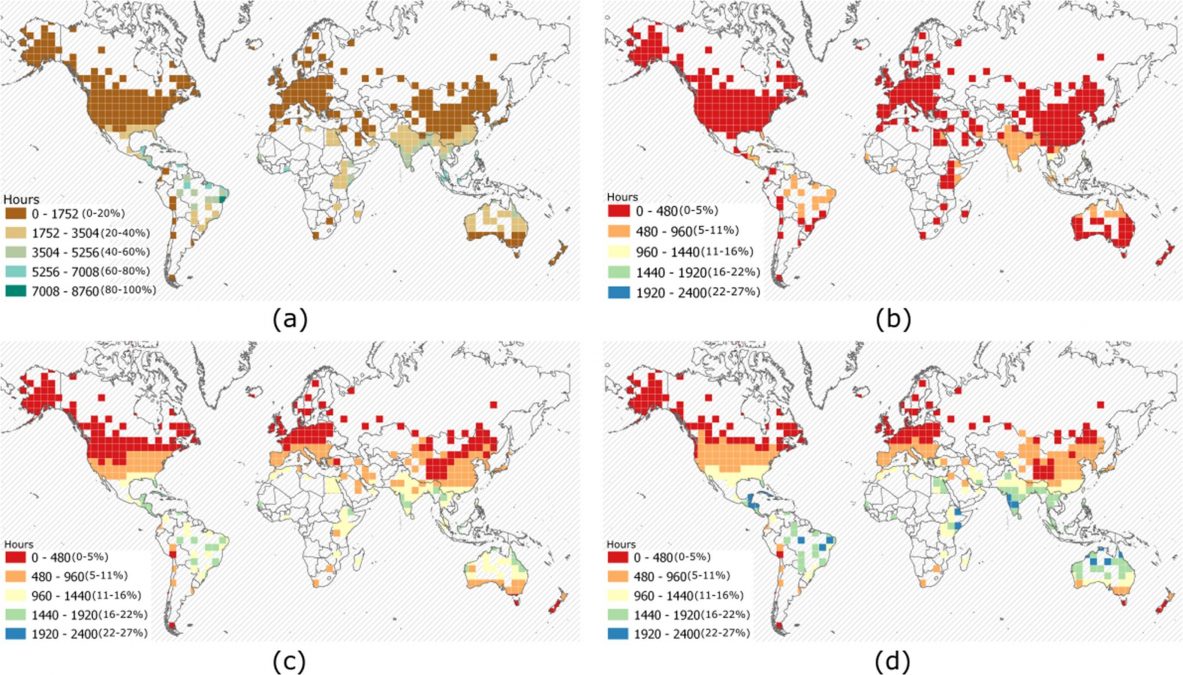By Molly A. Seltzer
In a study published in a COVID-19 edition of the journal Applied Energy, Princeton University researchers showed that an often overlooked cooling technology can enable more ventilation in buildings around the world while substantially decreasing energy costs. Radiant systems are an alternative to air conditioning and work by controlling the temperature of surfaces around people instead of the air. Radiant cooling panels have been around for over a century, but the Princeton researchers made them effectively condensation-proof using a special membrane to encapsulate the panels. The study found that with this upgrade, the technology could be used in every major climate zone, at least for part of the year, and could slash energy costs up to 25%. While the technology itself does not directly control ventilation rates, it allows for windows to be opened and more fresh air to flow in because occupants feel comfortable from the radiant systems, regardless of the air temperature around them. All the air brought into a space can be fresh and used for breathing, rather than thermal comfort, which is particularly relevant today as the world continues battling COVID-19, an airborne virus easily transmitted in indoor spaces.
Cooling using radiant systems, not air conditioning
Radiant systems rely on radiant heat transfer, or radiation, a thermal comfort principle that is often unaccounted for when evaluating how to keep people cool. Radiant heat constantly flows from warm to cooler surfaces. It accounts for 50% of how people feel in a space, with the other half being air temperature. Radiant heat transfer is the reason that people feel warm near a fire or cool near a window on a frigid day, regardless of the temperature of the air around them. The systems are comprised of small cold-water pipes enclosed within a transparent membrane, which are then placed over walls and ceilings. With the radiant system, simply being near the panels is enough to make people feel cool as radiant heat flows away from their bodies to the cold panels, making them feel cooler.

Forrest Meggers, assistant professor of architecture and the Andlinger Center for Energy and the Environment, has spent years studying radiant systems and how they can help make buildings more efficient. After analyzing the increased energy toll and costs of providing extra ventilation in response to the COVID-19 pandemic, Meggers and his lab saw an opportunity to bring back classrooms and other essential services using radiant systems.
“We realized we could double the efficiency while better mitigating COVID-19 risks,” said Meggers.
Reviving the classroom globally
The idea was that schools retrofitted with radiant panels could easily increase ventilation simply by opening windows and doors and moving air with fans. Teachers and children would be cooled by the panels and surrounded by more fresh air, and theoretically, less virus.
“Although our system requires a ceiling space reconfiguration, it does not require duct work or envelope retrofits, which means it can be widely implemented in existing spaces,” said Kian Wee Chen, a former Andlinger Center Distinguished Postdoctoral Fellow and a current postdoctoral researcher in Meggers’ lab.
Because classrooms, unlike high-rise office buildings, usually have windows that open and, in many cases are more susceptible to the virus because of the amount of people in one room, classrooms are the perfect candidate for the radiant systems. Chen said the retrofits would require plumbing work due to the water tubes in the system, but the task would not be very labor intensive or technically demanding. In November 2020, Chen showed that radiant cooling systems could enable 100% of the air flowing into the classroom to be fresh air from the outdoors, compared to recirculated air, in one of the hottest, most humid climates in the world, Singapore. Contrary to popular belief, they found that radiant systems can be effective for high-humidity environments, assuming there are fans and ways to move the air. The study demonstrated that conventional de-humification done by standard HVAC systems was not needed for people to feel comfortable. The research showed exactly how a classroom could be retrofitted with the radiant panels to allow for the students to feel cool.

With that study yielding positive results for classrooms, the researchers wanted to explore exactly where in the world this technology could be useful. To do this, they designed models that incorporated weather conditions, like humidity, wind, dew point and others, and found that, in the 60 cities they studied, the system could be used for much of the year in most buildings. On average, buildings would see an annual energy cost savings of 10-25% against their baseline, and even more so against the operational upticks of the pandemic.
The researchers found the technology would yield the most energy and cost savings in places like Singapore, Rio de Janeiro, and Miami because existing air conditioning systems require lots of energy to dehumidify the air before sending it into buildings, which radiant systems do not require. In those places, air conditioners could be kept off and radiant systems run in their place for 70% of the year. In other parts of the world, when temperatures were between 50- and 90-degrees Fahrenheit, or about 10- to 32-degrees Celsius, the radiant system could be also used. Mechanical heating or cooling systems would be needed when temperature conditions were too extreme to be met by radiant systems. But the two systems could operate together, in a mixed mode of central air conditioning and natural ventilation, or with air conditioning or heating used only as backup and radiant systems and a separate mechanical ventilation system used instead. Both of those options require far less heating or cooling than if relying entirely on conditioning the air for comfort.

So, why hasn’t this been done?
The researchers said there are several reasons why this technology has not been widely adopted. It could be, in part, due to a technical problem described earlier in this piece, condensation.
Previously, the technology was difficult to implement in hot climates because condensation would form when the cool pipes in the system came in contact with hot air. Although radiant systems existed prior to air conditioning, Meggers’ addition was updating these panels with an insulated membrane to encapsulate the radiant cooling panels so that they are pervasive to radiation but not to air. This means the cool pipes would not touch the hot air, solving the condensation problem.
But, according to the researchers, there is also a larger, cultural issue at play: air conditioning is ingrained in American life and buildings. Air conditioning was a sign of wealth in the 1950s and also two decades later when central systems replaced window units. Because buildings have now been designed to be air tight and only in contact with outdoor air through air conditioning systems, there are few tools and design norms for alternatives.
Chen said, with the global COVID-19 pandemic, there is a real need to reevaluate HVAC systems and an opportunity to create lasting change, both among the American public and in the design industry.
Designing for the future
Dorit Aviv is an assistant professor of architecture at the University of Pennsylvania’s Weitzman School of Design and a co-author on the latest paper. She completed her Ph.D. in Meggers’ lab in 2020.
Aviv said, “If architects assume an air-tight building envelope with an HVAC system, detailing would be very different from a building that allows for natural ventilation. But, if you think about it, buildings were designed in ways that encourage natural ventilation for centuries before air conditioning.”
Meggers’ group is working on developing a thermostat equivalent for buildings that rely on radiant systems instead of air conditioning. Vents and filters can also be used to bring in the air to control allergens, dust and pollen.
The researchers said they hope they can test more deployments and provide guidelines for construction and use of the systems. They aim to further investigate how classrooms can be retrofitted and how radiant systems may help the world beat COVID-19 without a massive toll on the environment, and keep life moving.
Other authors of the study include: Eric Teitelbaum, Denon Sheppard, Jovan Pantelic, and Adam Rysanek.